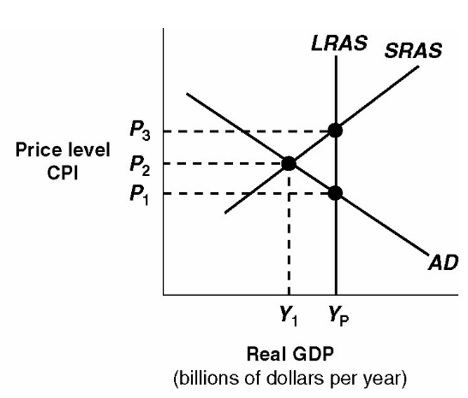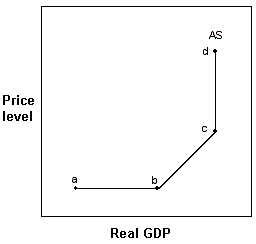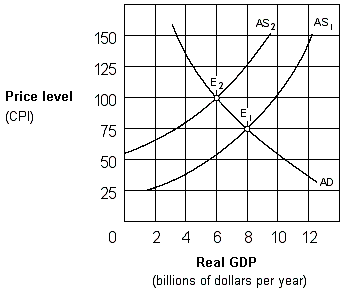A) consumption plus investment plus government spending plus exports.
B) consumption plus investment plus government spending plus (exports minus imports) .
C) consumption plus investment plus (taxes minus transfers) plus (exports minus imports) .
D) consumption plus investment plus government spending plus (imports minus exports) .
Correct Answer

verified
Correct Answer
verified
Multiple Choice
When prices rise, consumers and businesses hold larger money balances. This reduces the supply of loanable funds, increases the interest rate, and discourages both consumption and investment. This process is called the:
A) interest-rate effect.
B) real balance effect.
C) investment effect.
D) disinvestment effect.
Correct Answer

verified
A
Correct Answer
verified
Multiple Choice
Suppose the price level falls. The result is that the:
A) aggregate supply curve would shift to the right.
B) aggregate supply curve would shift to the left.
C) general price level would rise causing a movement up the aggregate demand curve.
D) aggregate demand curve would slope downward because of the real balances effect.
Correct Answer

verified
Correct Answer
verified
Multiple Choice
Which of the following would shift the aggregate demand curve to the left?
A) An increase in exports.
B) An increase in investment.
C) An increase in government spending.
D) A decrease in government spending.
Correct Answer

verified
Correct Answer
verified
Multiple Choice
In the intermediate range of the aggregate supply curve, higher aggregate demand will increase:
A) both the price level and real GDP.
B) real GDP without raising the price level.
C) the price level without affecting real GDP.
D) the price level but reduce real GDP.
Correct Answer

verified
Correct Answer
verified
Multiple Choice
 Macro AD-AS Model
In Exhibit 14A-4, the level of real GDP represented by Y p :
Macro AD-AS Model
In Exhibit 14A-4, the level of real GDP represented by Y p :
A) would be associated with considerable unemployment.
B) indicates that the economy is experiencing zero inflation.
C) indicates the short-run equilibrium level of real GDP.
D) is potential real GDP for this economy.
Correct Answer

verified
Correct Answer
verified
Multiple Choice
Exhibit 14-1 Aggregate supply curve
 In Exhibit 14-1, higher price levels allow producers to earn higher profits, stimulating production and employment in:
In Exhibit 14-1, higher price levels allow producers to earn higher profits, stimulating production and employment in:
A) the segment labeled ab.
B) the segment labeled bc.
C) the segment labeled cd.
D) both segment bc and segment cd.
Correct Answer

verified
Correct Answer
verified
Multiple Choice
The short-run aggregate supply curve (SRAS) is the amount of real GDP:
A) produced at various price levels.
B) produced at various savings rate levels.
C) purchased at various price levels.
D) purchased at various saving rate levels.
Correct Answer

verified
Correct Answer
verified
Multiple Choice
Which of the following events is the most likely to create stagflation?
A) An increase in the money supply.
B) A reduction in the amount spent on national defense.
C) A doubling of oil prices.
D) A decrease in investment spending.
Correct Answer

verified
Correct Answer
verified
Multiple Choice
Along the short-run aggregate supply curve (SRAS) , an increase (rightward shift) in the aggregate demand curve will increase:
A) both the price level and real GDP.
B) real GDP without raising the price level.
C) the price level without affecting real GDP.
D) the price level but reduce real GDP.
Correct Answer

verified
A
Correct Answer
verified
Multiple Choice
When moving along a market demand curve, the prices of related goods are assumed to be constant. With an aggregate demand curve,
A) the assumption is meaningless because we are using a market basket for all goods and services.
B) the prices of related goods have an inverse relationship.
C) all goods are assumed to have the same price.
D) the same assumption holds true.
Correct Answer

verified
Correct Answer
verified
Multiple Choice
Along the Keynesian range of the aggregate supply curve, an increase in the aggregate demand curve will increase:
A) both the price level and real GDP.
B) only real GDP.
C) only the price level.
D) real GDP and reduce the price level.
Correct Answer

verified
Correct Answer
verified
Multiple Choice
Other things constant, an increase in resource prices will:
A) increase aggregate demand.
B) decrease aggregate demand.
C) decrease aggregate supply.
D) increase aggregate supply.
Correct Answer

verified
Correct Answer
verified
Multiple Choice
Which of the following will most likely increase aggregate demand?
A) a decrease in stock market prices
B) an increase in business investment spending
C) a decrease in the expected inflation rate
D) a decrease in real GDP
Correct Answer

verified
Correct Answer
verified
Multiple Choice
Which of the following will most likely cause an increase in the aggregate supply curve?
A) a reduction in the general level of prices
B) an increase in the general level of prices
C) an improvement in technology that substantially reduces the cost of generating energy
D) an increase in taxes that makes it more expensive for Americans to import crude oil
Correct Answer

verified
Correct Answer
verified
Multiple Choice
The vertical portion of the aggregate supply curve shows that at full employment an increase in the price level will:
A) not alter the economy's full-employment real GDP.
B) increase the economy's full-employment real GDP.
C) reduce the quantity of goods and services purchasers will demand.
D) improve the overall efficiency of resource use.
Correct Answer

verified
Correct Answer
verified
Multiple Choice
In the aggregate demand/aggregate supply model, a country's full-employment real GDP is represented by:
A) prices.
B) aggregate demand.
C) aggregate supply.
D) an increase in the general level of prices.
Correct Answer

verified
C
Correct Answer
verified
Multiple Choice
Exhibit 14-2 Aggregate supply and demand curves
 In Exhibit 14-2, the change in equilibrium from E1 to E2 represents:
In Exhibit 14-2, the change in equilibrium from E1 to E2 represents:
A) cost-push inflation.
B) demand-pull inflation.
C) price-push inflation.
D) wage-push inflation.
Correct Answer

verified
Correct Answer
verified
Multiple Choice
Which of the following could not be expected to shift the aggregate demand curve?
A) net exports fall
B) consumption spending decreases
C) an increase in government spending
D) a change in real GDP
Correct Answer

verified
Correct Answer
verified
Multiple Choice
In the short run, an increase in the price level causes:
A) a rightward shift in the aggregate demand curve.
B) a leftward shift in the short-run aggregate supply curve.
C) a rightward shift in the short-run aggregate supply curve.
D) a movement upward along the short-run aggregate supply curve.
Correct Answer

verified
Correct Answer
verified
Showing 1 - 20 of 136
Related Exams